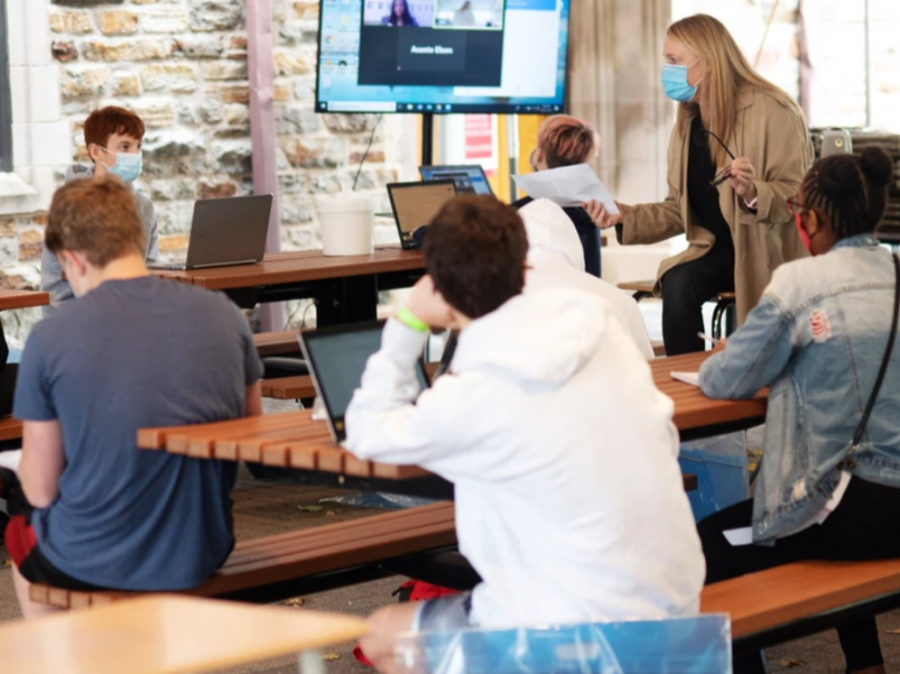We wondered:
This year, Upper School tuition at Friends School of Baltimore is $36,445. In the grade halls and the dining hall, we hear students ask this question a lot: Where does it go? Do any students understand?
“I really don’t. Maybe lunch, rent, and stuff for the store?” says senior Destini Jackson. “I don’t know.”
Junior Ejaz Ibrahim agrees.
“I don’t know. I don’t know the details of that,” he admits. “I don’t know where it especially goes.”
We didn’t know either. So a team of Quaker Quill reporters headed over to the business office, a white house at the southern edge of campus, to find out.
We asked:
Malcolm Haynes, Friends’ new Chief Financial and Operating Officer, sat down with us to explain how the school’s budget works. Here is our Q&A with him, edited and condensed for clarity.
Quill reporters: Can you give us statistics on where tuition goes?
Haynes: Generally speaking, tuition dollars go towards personnel. The people-costs here at Friends are the biggest expense.
If you look at it as a pie, about 72% of all the tuition dollars the school receives in any given year go towards teacher salaries, administrator salaries, and the benefits for those employees. All of our full-time employees are eligible for health insurance, so that is a big, significant expense.
Quill reporters: And the other 30%?
Haynes: About 20% is other kinds of non-personnel operating costs. So all those kinds of things it takes to run a school: the equipment the facilities team uses to keep the buildings warm and cool, and the elevators running, and the grounds maintained and well manicured – things like that. About 20% of our operating budget from tuition, and some other smaller sources, support those sorts of expenses.
The final 10% is what we call fixed costs – the kind that don’t really change from year to year. We’re always going to have to pay the light bills, right? That’s not a variable cost. Same thing with water and natural gas; we’ve got to pay the bills to keep the buildings running right.
The school also has a small amount of debt that was used to build some of the buildings on campus: mainly Forbush Atrium, and the Arts Center in Forbush. So there’s some debt that the school is still paying off, and will continue to pay off until 2026.
Another big part of our fixed-costs portion of the pie is insurance. As an organization that provides a service to the public, we have to insure ourselves against liability. If a tree falls on somebody’s car on the Friends School campus, and they decide to sue us, we have to make sure we’re covered, to cover the costs of that claim. Hopefully they don’t, but better safe than sorry.
Quill reporters: How much money does the school have, in all? And how much of it comes from things besides tuition?

Haynes: The school’s operating budget is about $22 million. When we talk about that pie, we’re talking about tuition dollars, mainly. Of that pie of $22 million, about $18 million is actual tuition dollars. (You’ll recall that the Board of Trustees, which governs the management of the school, approved a 4.5% tuition increase for this current academic year. The main reason for that is to support the ongoing operations of the school: anything from textbooks and athletic uniforms to lab supplies and office supplies.)
And then, we draw some money from the school’s endowment. The endowment is a collection of funds that supporters of the school have given for use “in perpetuity.” The idea is: I’m going to give a significant sum of money to the school and I want the school to keep using those dollars for a specific purpose, and it’s up to me to determine what that purpose is. The school takes that money and invests it, because we want that money to grow and always be available to support the intent of the gift. The school’s endowment is about $40 million. So that’s that’s off to the side, and we periodically draw money from the endowment based off of the purposes of the gifts. We draw about $1.4 million from the endowment every year.
So if you’re keeping score, we got 18 million of tuition, then we got like 1.4 million from the endowment. That gets us to 19.4 million, and our total budget is 20-22 million. The remaining dollars come from – we operate a bunch of auxiliary enterprises, our business-like activities that we do in addition to our regular academic program. We operate summer camps, we have the early child care center Little Friends, and revenues for those entities and activities also come in to complete the pie.
So that comprises our operating budget. It’s tuition. It’s our endowment. It’s our auxiliary activities.
The last piece is annual giving. We have an annual fund campaign every year that raises about $850,000. These are current-use gifts. So they’re not like that endowment piece, where I want these dollars to last forever, so I’m going to invest them and draw just a little bit from them each year. These are more like we’re having a phone-a-thon.
I don’t know if your parents listen to public radio, but they’re having this campaign right now – I kind of hate it, because it takes away from the regular programming, but it’s necessary – where they are like, “We need to raise $5,000 today in order to pay the bills.” That’s kind of what we do with the annual fund.
So those are the main elements of the pie.
We learned:
The pie chart above gives statistics on the school’s budget allocation. Around 70%, in green, goes toward faculty and staff salaries, health insurance, and other benefits. The next section of this graph, in orange, goes towards facilities, which equates to around 20% of the school budget. The remaining 10%, in yellow, is for fixed costs, things that stay around the same expense from year to year, like insurance, utility bills, and debt from past construction.
In summary, every year, Friends has an operating budget of around $22 million. It also has an endowment of about $40 million in investments, and every year the school pulls around $1.4 million from those. It also raises around $850,000 from Annual Giving donations, and around $1.7 million from Little Friends, summer camps, and building rentals. That makes up the last $4 million of the $22 million.
That leaves the bulk of the school’s yearly operating costs – $18 million – that need to be paid by student tuition. So, while the tuition at Friends might seem high, it keeps the school running.














![How Freestyle Club Began [Podcast]](https://thequakerquill.org/wp-content/uploads/2025/05/charly-alvarez-Jv9untmB7G4-unsplash-1200x800.jpg)








![What makes you feel good about yourself? [Podcast]](https://thequakerquill.org/wp-content/uploads/2025/10/madison-oren-uGP_6CAD-14-unsplash-1200x800.jpg)




![A Phone Ban at Friends? [Podcast]](https://thequakerquill.org/wp-content/uploads/2025/05/magenta-VrRT19_ZjUY-unsplash-1200x900.jpg)









